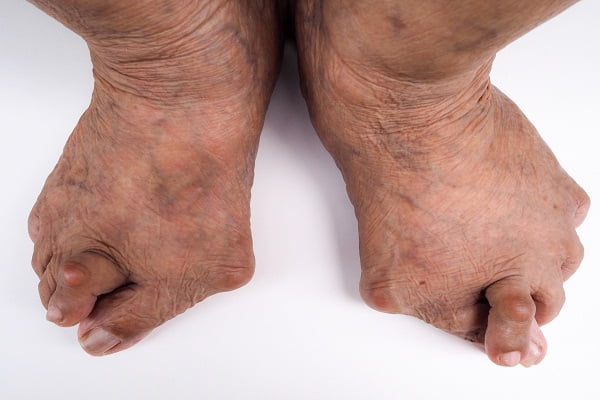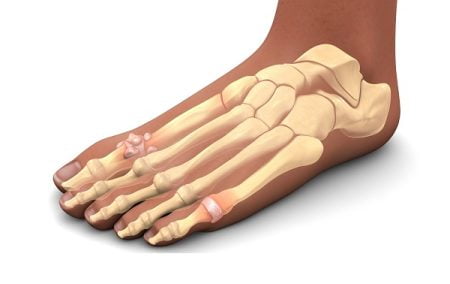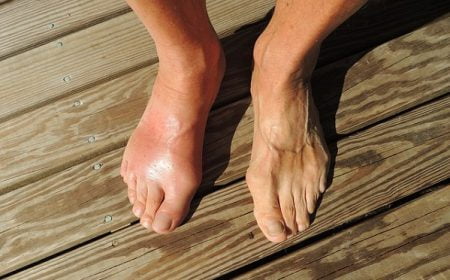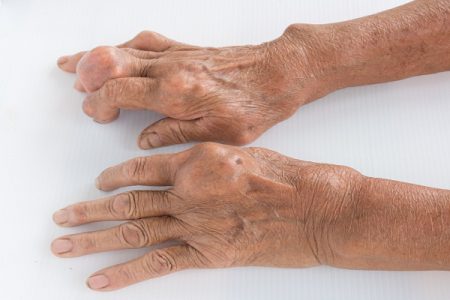Most Common Places For Gout: Where Do You Get Gout?
- Updated on: Jul 13, 2024
- 4 min Read
- Published on Oct 3, 2019


What are the common places for gout?
Almost 90% of the times, gout involves joints in the lower extremities of your body. The classic location for gout to occur is the large joint in the big toe.
Podagra is the medical term for inflammation at the base of the big toe. However, gout can also affect other joints in:
- foot
- knee
- ankle
- elbow
- wrist
- hands
- fingers
Longstanding and severe gout can affect multiple joints at the same time. This causes joint stiffness and pain in multiple joints.
What is tophi?
Another common sign of gout is the presence of tophi. It is described as a hard nodule of uric acid that deposits under the skin. It can be found in various locations in your body, commonly on the elbows, upper ear cartilage, and on the surface of other joints.
Presence of a tophus is an indication of overloading of your body with uric acid. When tophi are present, it implies that the uric acid levels in your bloodstream typically have been high for years. Longstanding and untreated gout can lead to joint damage and physical deformity.
Which parts of your body are commonly affected by gout?
Gout in fingers and gout in thumb
An important feature of the gout in fingers is that fingers are not usually the first attack location. Before turning its attention to the fingers, gout will probably have attacked other body joints. This means that when gout attacks happen in the fingers, it would have already been present for some time in other locations. Therefore, uric acid levels would probably be high, if the treatment for gout hasn’t lowered it.
A second feature of gout attacks in your fingers is that it lasts longer and usually lasts for more than 10 days on an average. You can also get gout in your knuckles which join your fingers to the hand. Finger gout is generally more common in older people because they get much time to build up uric acid in the blood.
Any of the fingers can be attacked by the gout and there is no likeness for gout to occur in your thumb more than any other finger. Gout in thumb is as likely to develop as gout in any other finger.
Gout in wrist and gout in hand: Can gout occur in your hands?
Gout in the hands can manifest itself in deep locations and be very hard to remove unless you recognize the signs early and take appropriate action. Like other joints of the body, the pain that comes with symptoms of gout in the hands is brought by the excess uric acid in your blood.
Hand gout is not very common, but the wrist, hands, and fingers are also at risk. Gout in hand initially starts with an odd ache, then the stiffness sets in which causes inflammation resulting in redness and heat.
Hand gout can be clinically diagnosed with established diagnostic methods and treated accordingly.
Gout in arm and elbow: Can gout affect your elbow and arm?
The elbow is formed by three bones out of which two bones belong to the forearm and known as the radius and ulna. The third bone, which is also the largest and the only bone in the upper arm, is called the humerus. It is important because it helps in lifting, throwing and writing. Uric acid crystals will typically deposit in the middle section where are all three bones connect in the joint capsule of the elbow.
A gout attack in your elbow will also happen unexpectedly. You will wake up in the morning to find that your elbow is suddenly swollen and painful. You will experience severe pain and tenderness, just like the big toe, your elbow will be extremely sensitive to any pressure even to a bed sheet.
Your elbow will have red and swollen appearance as if it’s puffed up and you may feel warm. Your arm mobility will be limited. Due to the redness, the skin on your elbow may be peeling and flaking. You may feel itchy as well due to gout in elbow and arm.
Gout in shoulder: Can gout affect your shoulder?
For many people, the first symptom of gout is unbearable pain and swelling in the big toe which often occurs after a trauma, such as an illness or injury. Later attacks may occur in other joints, typically the feet, ankles, knees, hands, wrists, and elbows.
Attack on shoulder is less common but can happen.
Gout in big toe: Can you get gout in any toe?
Most common place for gout is the big toe because uric acid is supposed to be sensitive of temperature changes.
At cooler temperatures, uric acid turns into crystals. Since the toe is the body part that is farthest from the heart, it is also the coolest part of the body and, thus, the most likely target for gout attack. However, gout can affect any joint in the body.
Can you have gout in your knee? Can you have gout in your knee joint?
Majority of people get their first gout attack in their toes, but as it gets worse it may reach to your knee.
Deposition of uric acid crystals in the knee joint leads to a condition commonly known as “gout knee” and it can virtually paralyze you during its attack. The knee joints have severe and intense pain with swelling which makes the joint stiff and difficult for you to use it at all. When a gout attack happens in your knee joint, it gets very tender and hot and you cannot even fold your leg.
It can be clinically diagnosed by the examination of synovial fluid for deposition of uric acid crystals and can be treated accordingly.
Gout in foot (top of foot) and gout in ankle
Gout in foot and particularly gout in top of foot is a common problem and is marked by characteristic and sudden intense pain, often starting at night with no warning.
The classic symptoms of gout in top of foot are localised pain, swelling, redness, heat and tenderness which most commonly occur in the big toe but can also affect other parts of the foot and ankle.
Gout attack in the ankle joint is possibly the most crippling in nature. The symptomatic pain that results from the attack on all the delicate bone structures of the ankle is intense and unbearable making your walk almost impossible and crutches become a reality for many people.












